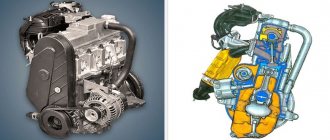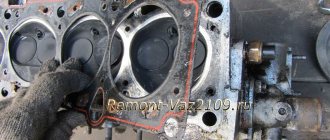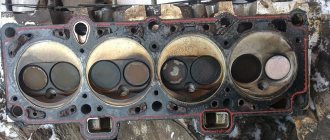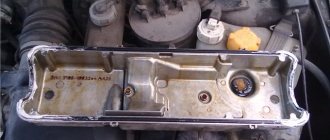valve grinding is a simple procedure, provided that the car owner has previously had experience in performing repair work. To carry out lapping of valve seats, you will need a number of tools and materials, including lapping paste, a device for dismantling valves, a drill (screwdriver), kerosene, and a spring with a diameter extending into the hole of the valve seat. In terms of time, grinding in engine valves is a rather expensive procedure, since to perform it it is necessary to dismantle the cylinder head.
Why do you need to grind valves?
If the procedure is not followed, the valves may not function properly - for example, they may allow gasoline and air to pass into a closed combustion chamber. This will degrade the engine's performance and may lead to breakdown over time. Lapping helps to achieve maximum tightness. Work must be done not only after installing new valves; it is often necessary in cases where the products have not been changed for a long time. The reason for the car's "jerking" at idle may be the difference in compression in the cylinders. Grinding in is the only way to deal with the problem.
About soot
After long-term use of the vehicle, carbon deposits on the surfaces of the valve and seat chamfers, microcracks and scuffs appear.
As a result, the contact patch between the surfaces decreases, the valve does not fit tightly to the seat, which is why it begins to leak and the engine’s compression decreases.
To remove carbon deposits, shells, and scuffs, valve lapping is used, as a result of which the contact patch between the valve and the seat is restored.
In addition to performing this operation as part of a major overhaul, valve grinding is carried out in a number of cases.
So, these works are carried out:
- If the valve or seat burns;
- When the valve disc burns out;
- When replacing them in case of damage, in general, whenever problems arise with these elements.
Do-it-yourself valve grinding at home
➤ Using a special machine. In fact, such a unit does not perform grinding - it chamfers the seat and valve, thanks to which it is possible to achieve the tightest possible alignment and ensure precise mating. The result is a high-strength cut profile that ensures high-quality engine operation. The advantage of the method is its simplicity - after processing, all that remains is to wash and assemble the head.
Lapping valves using a machine
➤ Using a hand cutter. Don't have a machine? Use a hand router. There are many units of this type, each of which is designed for a specific engine model. Using a cutter you can process old valves. The advantage of the method is high accuracy and no need to look for expensive equipment. ➤ Do-it-yourself lapping. If the valve does not need to be seriously adjusted, if there is neither a machine nor a cutter at hand, this option will be the best choice. Irregularities are removed with abrasive paste, after which the product can be safely used. The main advantage of the method is that it can be used at any time, anywhere.
Cone for removing excavation
This tool is used to restore valve seats. To determine whether you need to use a roller cutter or can do without it, you should inspect the saddles. They can be covered with soot and shells, but if the chamfers have the correct conical shape, you can immediately proceed to lapping; otherwise, if the chamfers are rounded or have steps on them, you will need to give them the correct shape using a cutter.
Article on the topic: How to change the thermostat on a VAZ car with your own hands
Since the shapes and sizes of the seats on different heads are different (for example, for the VAZ-2106 and VAZ-2109), you need to select the appropriate tool. Seats can be processed manually or, to save time, using a drill. To do this, the cutter is fixed in the chuck, like a regular drill, and under its influence the surface layer of metal is removed. The signal to stop removing the excavation is the appearance of a shiny, even circle, the shape corresponding to the valve plate.
In the video you can see how the saddles are processed with a rolling cutter.
Basic rules and secrets
To carry out the process, you need to remove the cylinder head. ➤ To remove the valves from the bushings that guide them, you must first remove the valve springs. To do this, you can use valve tools available in specialized stores. ➤ Usually a rubber hose and clamps are put on the rod of the device. Instead, you can use a tip with a through threaded hole in the side wall. A bolt is screwed into this hole to secure the valve stem. ➤ Before lapping, inspect the valves. If they show signs of deformation (bends and cracks), such products cannot be used. Replace them with new ones. Is there carbon deposits? Clean it - you can use a stiff brush for this.
Lapping Tools
Lapping devices are divided into 2 groups. 1.
Clamping the valve from above, fixed on the rod.
There is a handle on one side. To achieve the result, you need to pull and rotate it. 2.
"Suckers". They are fixed on the valve plate and are also equipped with a handle. To use, you need to press the valve against the plate and rotate the device in different directions.
Valve lapping tool: top clamping model
If you don't have a tool, a screwdriver or drill will do. Regardless of the tool you choose, you will need the following equipment: ✔ abrasive or diamond paste; ✔ spring - such that you can easily squeeze it with your hands and put it on the valve; ✔ kerosene. Can't get hold of abrasive paste? Prepare it! To do this, you will need fine-grain sandpaper or sandstone shavings. Remove the stones from it and mix them with grease or a similar substance in a ratio of 2 to 1. The consistency of the mixture should resemble shampoo. In extreme cases, standard motor oil will work as a base.
Applying abrasive paste
Pasta selection
The choice of abrasive pastes for lapping in modern stores can shock any novice driver. We won’t talk about price, since the choice for this parameter depends entirely on the capabilities and personal preferences of the buyer. Factors such as composition and grain size are more important, so they are worth considering:
- For beginners, it is better to avoid using coarse-grained pastes, otherwise the slightest mistake will lead to defects in the seat and chamfer. Medium grit is preferable when it comes to basic machining, while fine grit is needed for sanding.
- Often the equipment includes two containers with pastes with compositions of different grain sizes.
- If you didn't bother buying pasta, you can make it yourself. To do this, select sandpaper with a minimum grit level and remove the abrasive, mix the resulting powder with lubricant. Use GOI paste at the final stage to finish the surface. It should be mixed in the same way as with abrasive powder. It’s worth mentioning right away that the quality of grinding will be an order of magnitude lower than when using store-bought abrasives.
Do-it-yourself valve grinding on VAZ 2106, 2109, 2110, 2112, 2114, 2115
1.
Take the valve in your hands and put the spring on it.
Return the valve to its place, back to the car. 2.
Press it with your fingers and place the previously prepared tool on the leg.
3.
Use a screw to secure the tool to the valve.
4.
Apply abrasive paste to the grinding surface of the plate.
5.
Rotate the valve in both directions while grinding.
You need to perform about 5 movements, after which you should lift the product, turn it 90 degrees and repeat the steps. 6.
Perform the procedure until a matte gray ring appears on the plate and head seat.
7.
Upon completion of work on all valves, wipe them with kerosene and dry them thoroughly with a rag.
This is what the valve should look like after lapping.
Nuances worth knowing about
To an experienced repairman, the tips below may seem unnecessary, but a novice repairman should definitely remember the following:
- It is better not to remove all rockers (cams on the valves) right away. It is necessary that each valve gets its own rocker back. While the engine is running, the camshaft cam and the corresponding rocker grind in and if they are “separated”, unpleasant clicks may appear when the valves operate, despite the fact that they have been properly adjusted before.
- And you also need to understand that each valve must return to its place. Changing them even after grinding in would not be the best idea.
- You can use various abrasive pastes in your work. You can start with the largest and end with the smallest. This will improve the results obtained.
- For a better fit, it is sometimes suggested to use machine oil at the finishing stage.
Valve grinding is carried out using various abrasive pastes
- Do-it-yourself replacement of valves on a VAZ 2112 16-valve: video instructions
How to lap valves on a machine
If you have access to a machine, it is better to use it. 1.
Clamp the valve in a special clamp, turn on the machine.
The grinding wheel rotates quickly in one direction, the valve rotates in the other, more slowly. Carefully bring the product to the circle and rub it in. 2.
Do not sand the product too hard.
Stop processing as soon as the sanding process becomes continuous. 3.
Stop the unit, remove the valve and wipe it with kerosene.
4.
After this, you need to inspect the cylinder head. Examine the seats pressed into the head. They can be ground in only if there is no damage. If there is a burn on the saddles, work it with a rolling cutter until a gray ring appears all over the circle.
To process the saddles, you need this kind of cutter
Functionality check
There are three ways to check that the valve is properly lapping.
➤ Using a vacuum tester. The most reliable and simple option. Connect a tool to each hole on the intake and exhaust sides of the manifolds. Now use it. If the valves are poorly lapped, the vacuum level on the pressure gauge will be insufficient. ➤ Using kerosene. Reinstall the valves, place the combustion chamber head up and pour kerosene on top. Leave them like this for several hours. If the kerosene does not leak out, everything is in order. Experts do not recommend using this method as it is not very reliable. ➤ Using a pencil. We draw radial lines along the entire circumference of the working edge of the valve seat. We install the valve in place, press it firmly and rotate it in a circle. We take out the product and look at the pattern. If the lines are erased and evenly paint the surface, everything is in order. If there are irregularities, the grinding was performed incorrectly. Grinding in the valves ensures normal engine operation. Be sure to regularly resort to the procedure - this way you can avoid problems with the power unit.
Minuses
- The undoubted disadvantage of internal combustion engines is the high degree of emissions generated during driving. The main problem is that the fuel does not burn completely. Only 15% of the combustible material is used to move the car, the rest flies into the air as a result of the fuel combustion chamber not reaching perfection. Exhaust gases include hundreds of harmful components, heavy metals and hydrocarbon derivatives.
- A gearbox is always required. This device is necessary in order to change the gear ratio, which regulates the number of engine revolutions, which in turn transmits energy to the wheels, and they begin to rotate either faster or slower.
- The need to change the oil every 10,000 km. This is due to contamination of the fluid by small particles entering the engine, as well as when working waste appears from the pistons and crankshaft.
- High cost of fuel. The price per liter of gasoline or diesel fuel is steadily rising. At this rate, driving cars with internal combustion engines will be a great luxury. A way out of this situation can be the installation of gas equipment, since the price of gas is now 2 times less than the cost of gasoline, and so far remains around 23 rubles, depending on the region.
- Limited resource of cheap motors. Manufacturers of low-cost engines use low-quality parts that have a lot of wear. Although, with modern lubricants, the operating time can be significantly increased. The main thing is to change fluids and other consumables on time.
- Low efficiency. This indicator reflects the efficiency of the engine relative to the energy generated in mechanical forces. It is expressed as a percentage. Unlike electric motors, whose efficiency can reach 95%, the efficiency of internal combustion engines does not have such indicators. Efficiency losses occur as a result of incomplete combustion of fuel, heat costs, as well as losses on other equipment, such as an air conditioner, pump, generator.
Modern engines have stepped far ahead of their previous counterparts. Today they have no competitors. Perhaps, unless people come up with something radically new, such motors will exist in our world for many more decades. How I would like internal combustion engines to live forever, but their existence will end along with oil, and the era of electric engines will come.
But, despite the fact that internal combustion engines have earned universal love, they can cause a global environmental crisis. The emissions created by millions of cars into the atmosphere pose a real threat to our planet.











